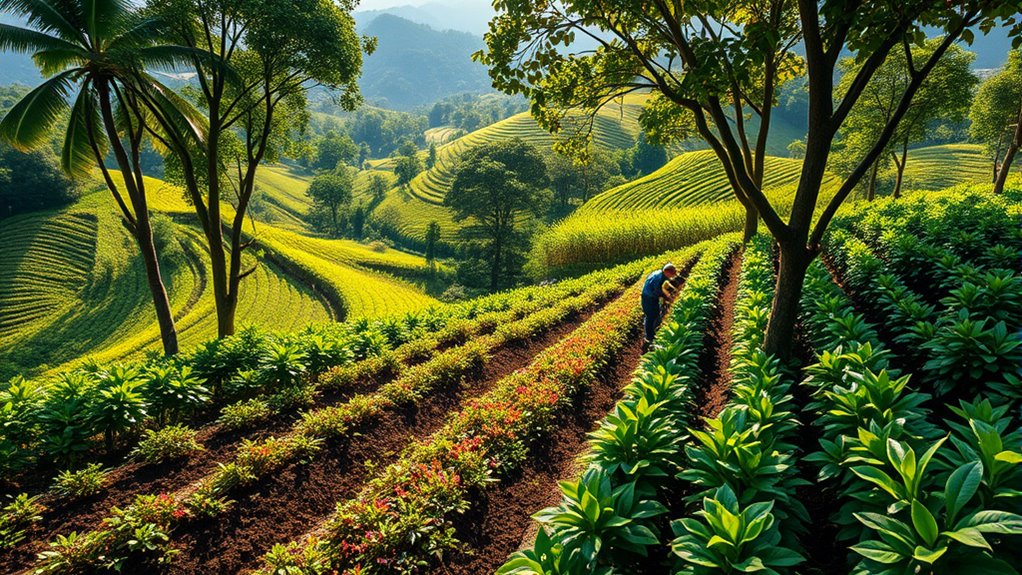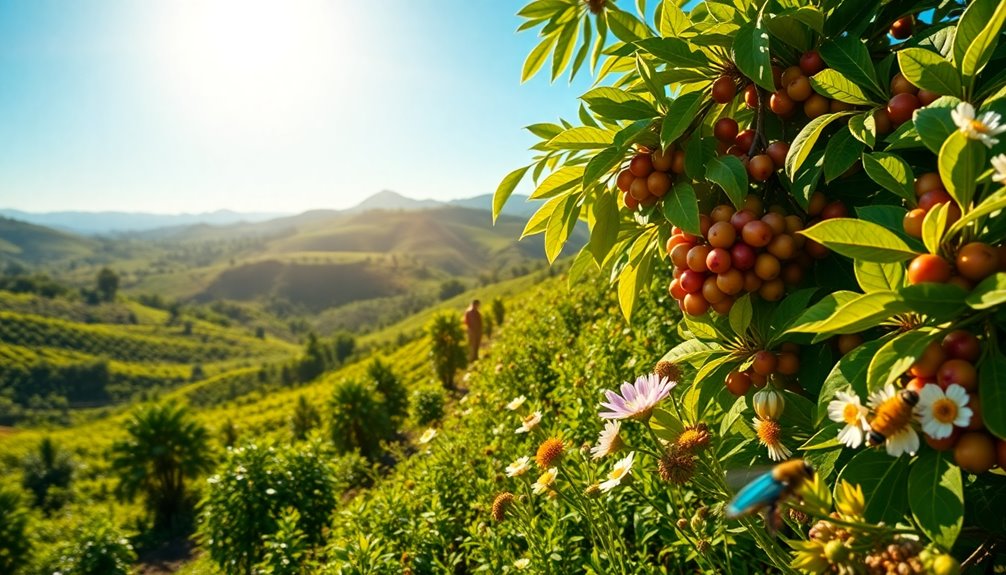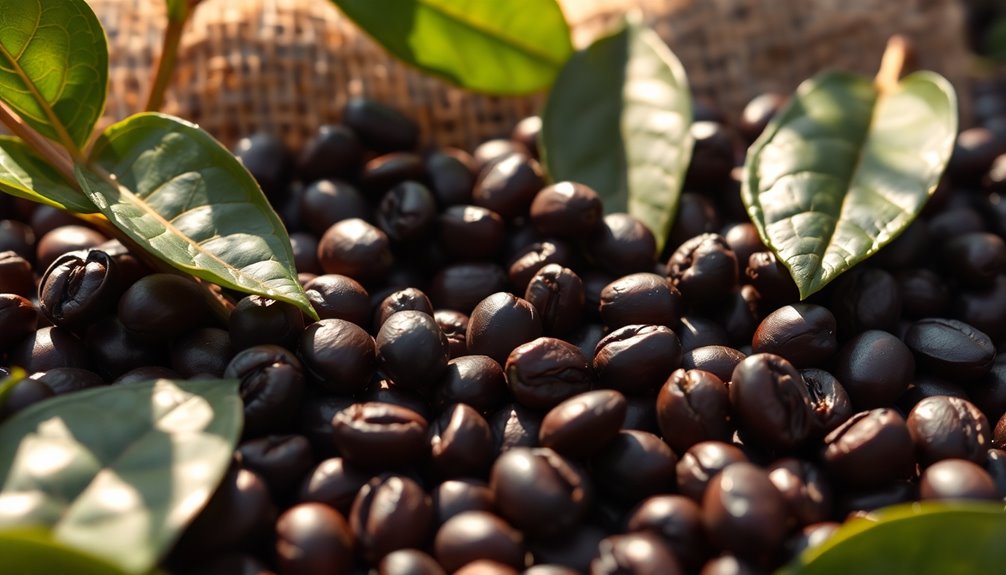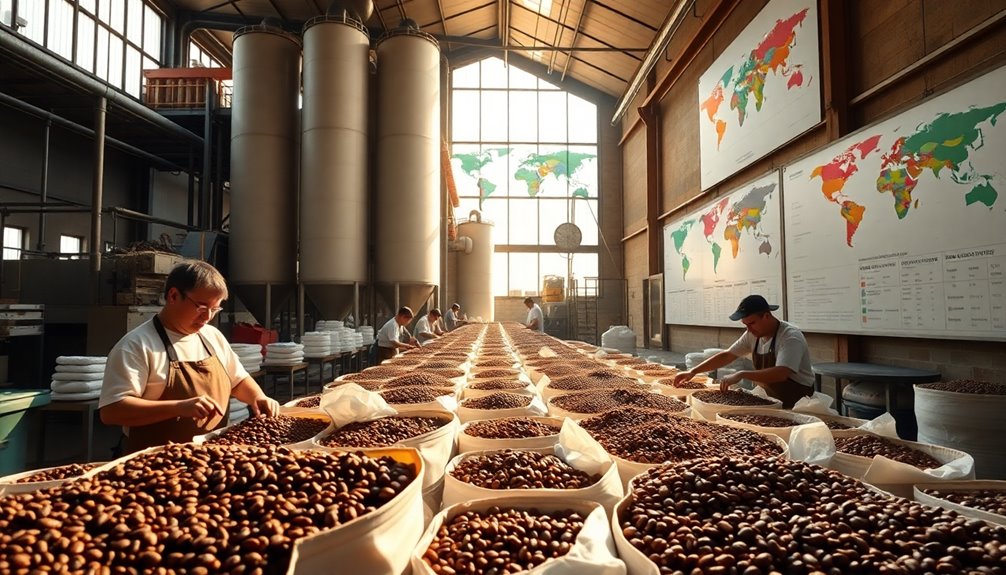Regenerative coffee farming involves practices like cover cropping, composting, minimal tillage, and crop diversity that improve soil health, boost yields, and help mitigate climate change through carbon sequestration. These methods make your soil more resilient to droughts, erosion, and heavy rains while supporting ecosystems. By adopting these techniques, you can create sustainable, profitable coffee farms that benefit the environment. If you keep exploring, you’ll discover how these practices can transform your approach to farming.
Key Takeaways
- Regenerative coffee farming employs cover cropping, composting, and minimal tillage to enhance soil fertility and resilience.
- These practices promote carbon sequestration, climate mitigation, and reduce erosion and runoff, benefiting ecosystems.
- Farmer education on soil biology, crop diversity, and sustainable pest management is essential for successful adoption.
- Community collaboration accelerates regenerative practice adoption, fostering shared knowledge and collective landscape improvements.
- Long-term benefits include increased productivity, profitability, ecological health, and resilience to climate change, with trade-offs involving initial labor and investment.

Have you ever wondered how coffee farming can benefit the environment instead of harming it? When you embrace regenerative practices, you’re not just growing coffee — you’re actively improving the land and supporting ecosystems. One of the key components of this approach is enhancing soil health. Unlike traditional methods that often deplete nutrients and lead to erosion, regenerative farming prioritizes building rich, fertile soil through techniques like cover cropping, composting, and minimal tillage. These practices help organic matter accumulate, increase microbial activity, and improve water retention, making the soil more resilient. As a result, the land becomes better equipped to withstand droughts and heavy rains, reducing erosion and runoff that can pollute nearby water sources. Additionally, integrating soil health into farming practices can lead to increased carbon sequestration, helping mitigate climate change impacts.
Embracing regenerative coffee farming improves soil health and supports resilient ecosystems.
But implementing these practices isn’t just about the land—it’s also about empowering the farmers who work it. Farmer education plays an essential role in shifting to regenerative coffee farming. When farmers learn about soil biology, crop diversity, and sustainable pest management, they become capable of making informed decisions that benefit their land and livelihoods. Educational programs, workshops, and peer-to-peer knowledge sharing are crucial for spreading awareness of regenerative techniques. As you gain this knowledge, you’ll see how small adjustments—like planting shade trees or rotating crops—can lead to healthier soil and more sustainable yields. Education also helps dispel misconceptions that sustainable methods are less productive or more labor-intensive. Instead, you’ll find that with proper training and support, these practices can increase long-term profitability and environmental benefits.
Furthermore, farmer education fosters a sense of community and shared responsibility. When you’re part of a network of growers committed to regenerative principles, you can exchange ideas, troubleshoot problems, and celebrate successes together. This collective effort accelerates adoption and ensures that the benefits extend beyond individual farms to entire landscapes. Improved soil health, achieved through continuous learning and application of regenerative techniques, not only boosts productivity but also helps sequester carbon, supporting climate change mitigation. You’re actively participating in a movement that balances economic viability with ecological health, proving that coffee farming can be both profitable and sustainable.
In the end, the shift to regenerative coffee farming hinges on your willingness to learn, adapt, and prioritize soil health. By investing in farmer education and applying these practices, you’re helping to restore ecosystems, safeguard water quality, and create a more resilient environment for future generations. It’s a powerful reminder that sustainable coffee production is possible when you focus on nurturing the land rather than exploiting it.
Frequently Asked Questions
How Does Regenerative Coffee Farming Impact Local Communities?
You’ll see that regenerative coffee farming positively impacts local communities by fostering community engagement and supporting cultural preservation. As farmers adopt sustainable practices, they often collaborate with locals, strengthening social bonds. This approach empowers communities to maintain their traditions while improving livelihoods. By prioritizing local knowledge and needs, regenerative farming creates a sense of ownership, ensuring that cultural heritage thrives alongside environmental and economic benefits.
What Are the Initial Costs of Transitioning to Regenerative Practices?
You’ll face initial costs when shifting to regenerative practices, mainly due to economic barriers like upfront investments in new equipment, soil amendments, and training. These costs can be significant, requiring careful planning and sometimes external support. Although the initial investments may seem high, they often lead to long-term benefits such as improved soil health, higher yields, and greater resilience, making the shift worthwhile despite the early financial challenges.
Can Regenerative Coffee Farming Increase Crop Yields?
You might find that regenerative coffee farming boosts your crop yields like a well-tuned engine. By improving soil health and managing pests naturally, your plants thrive better over time. Healthier soil retains more nutrients and water, leading to stronger coffee beans. Plus, integrated pest management reduces damage without chemical reliance. With patience, these practices can transform your farm into a productive, resilient landscape, increasing yields sustainably.
How Do Regenerative Practices Affect Coffee Bean Flavor Profiles?
Regenerative practices enhance soil health, which directly influences coffee bean flavor profiles. As you adopt methods like cover cropping and composting, you’ll notice increased flavor complexity in your beans. Healthy soil fosters diverse microorganisms and better nutrient absorption, leading to richer, more nuanced flavors. By prioritizing soil health through regenerative techniques, you can produce coffee with distinctive, vibrant flavor profiles that stand out to consumers.
Are There Government Incentives for Adopting Regenerative Coffee Methods?
Think of government incentives like a gentle rain nourishing your coffee farm’s roots. Yes, there are policy incentives and government subsidies available to encourage regenerative coffee methods. These programs aim to support sustainable practices, making it easier for you to adopt eco-friendly techniques. By taking advantage of these incentives, you can reduce costs and boost your farm’s resilience, all while contributing to healthier ecosystems and better coffee quality.
Conclusion
Think of regenerative coffee farming as planting a garden that blooms year after year. By adopting these practices, you nurture the soil, support local ecosystems, and create a resilient, thriving landscape. While there are trade-offs, your efforts can turn your farm into a living, breathing harmony of nature and cultivation. Keep tending this garden with care and purpose—your dedication helps grow a sustainable future, one coffee bean at a time.










